WASHINGTON, D.C. -- On average, fewer American adults reported having the flu "yesterday" in November (2.4%) than did so in October (2.7%), according to data from the Gallup-Healthways Well-Being Index. The decline puts the number of flu cases reported in November of this year below the number reported in November of last year, even amid concerns about the potential widespread impact of H1N1.
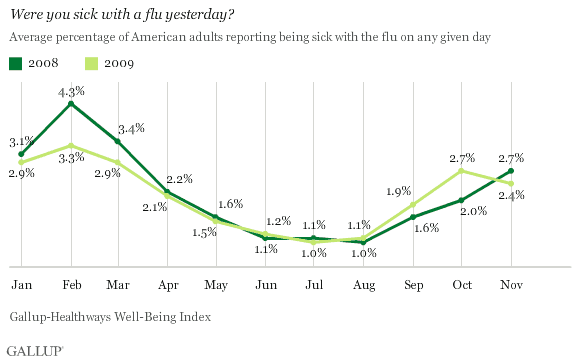
The President's Council of Advisers on Science and Technology estimated in late August that as many as 50% of Americans could contract the H1N1 virus this season (compared with 5% to 20% who get some form of influenza in a typical year). While the Gallup-Healthways data cannot estimate the cumulative percentage of Americans who have the flu, the average daily numbers clearly indicate there has not been a dramatic increase this year relative to the same months in 2008.
The Gallup-Healthways Well-Being Index surveys a random sample of at least 1,000 adults each day, or roughly 30,000 adults a month, on a wide range of topics related to health and wellbeing. One of the questions asked each day is, "Were you sick with any of the following yesterday?" The question specifies four illnesses: the flu, a cold, a headache, and allergies.
The reported daily prevalence of colds has also abated, dropping from 7.7% in October to 6.9% in November. The November 2009 figure is now two percentage points lower than November 2008's 8.9% figure.
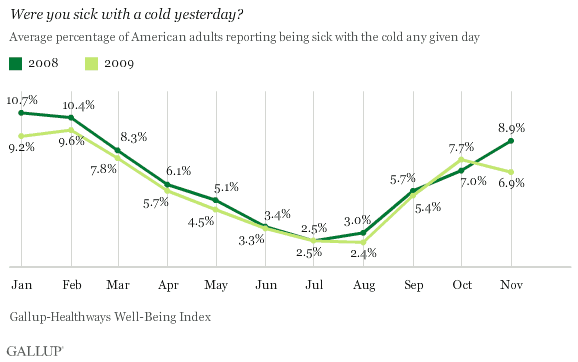
The measurement of colds vs. the flu in a survey research environment is complex because of the overlapping symptoms of the two disease conditions and misunderstanding by many Americans regarding what symptoms constitute "the flu" versus "a cold." In general, the percentage of Americans that report having a cold the day before is roughly three times the percentage that report having the flu. Still, the opportunity for year-over-year comparisons with 2008 data serving as a pre-H1N1 "control group" provides useful insight into the self-reported prevalence of each condition relative to the other, as well as their respective changes with the previous year. So far, year-over-year comparisons of cold incidence also remain similar -- or even lower -- to 2008's levels since the beginning of the H1N1 outbreak in April.
Decline in Flu Incidence Since October Greater for Households With Children
Cold and flu incidence varies among demographic groups. Women -- often the primary household caregivers -- are somewhat more likely to report having the flu and a cold than men. Additionally, respondents of either gender living in households without children are a third less likely on any given day to have the flu and are a fourth less likely to have a cold than are households with children. Each of these groups saw a decline in self-reported flu cases in November compared with October, with households that include children dropping the most (but still higher than those households without children).
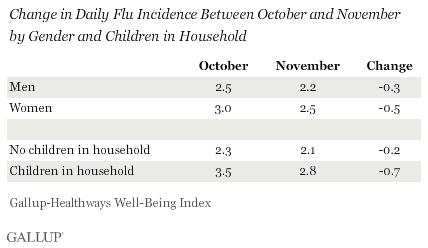
Asians Only Major Race/Ethnic Group Reporting Increase in Flu Incidence in November
Hispanic Americans have up until now been more than twice as likely to report having the flu or a cold than whites, blacks, and Asians. In November, however, self-reported daily flu incidence among Asians was nearly as high, tripled compared with the October figure.
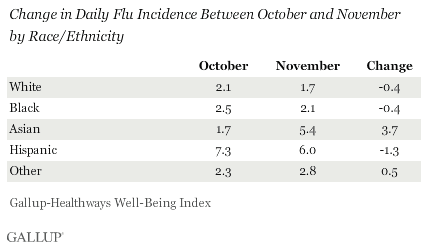
Those Aged 30 to 44 Report Drop in Flu Incidence in November
Among the major age groups, all were flat or effectively unchanged in November except for the group most likely to have young children at home, the 30- to 44-year-olds. The percentage of these young-to-middle aged adults that reported having had the flu on any given day dropped by one point in November compared with October.
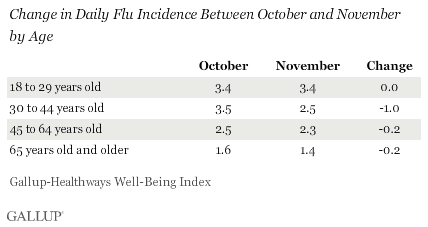
Observations and Implications
One month does not make a trend, but the measured decline in self-reported flu incidence is consistent with recent statistics compiled and released by the Centers for Disease Control and Prevention (CDC). On Dec. 4, the CDC reported that Pandemic H1N1 influenza continued to decline in the United States, with 25 states reporting widespread activity during Thanksgiving week, compared with 32 states the week before. Gallup's monthly trending is consistent with these findings. Still, many more months of the cold and flu season remain, with the historical peak month of February two months away.
Many factors may be contributing to the encouraging decrease in flu/cold incidences from October to November this year compared with last year, starting with an aggressive, if inconsistent, rollout of large-scale H1N1 vaccinations nationwide. Concomitant with this rollout has been an elevated awareness and sensitivity to contracting the flu that may have simultaneously increased those seeking out vaccinations for regular seasonal influenza. Other factors can include large-scale efforts by schools and community public health officials to encourage behaviors of more conscientious hygiene such as hand washing and coughing in to shirt sleeves rather than in to hands.
Still, the 1.7% to 5.4% one-month increase among Asians represents a statistically significant spike. The increase raises some concern for this stratum of the American population and underscores the underlying need for continued tracking for more narrowly defined demographic groups such as this one.
Overall, the decline in flu and cold cases from October to November raises the possibility that the predicted potential impact on the U.S. economy from H1N1 may indeed not come to pass, especially if fewer than expected workers miss work resulting from such illnesses. Analysts and economists fearful of the affect of a widespread H1N1 outbreak during a severe global economic downturn may find positive signs here.
Gallup will continue to track the self-reported incidence of colds and flu over the coming months to gauge the real-time impact of flu season.
Learn more about the Gallup-Healthways Well-Being Index.
Survey Methods
Results are based on telephone interviews with 29,192 national adults, aged 18 and older, conducted in November 2009. All monthly samples are near 30,000 per month. For monthly results based on the total sample of national adults, one can say with 95% confidence that the maximum margin of sampling error is ±0.6 percentage point.
Sample sizes for the reported demographics groups from November of 2009 are shown in the following graph.

Interviews are conducted with respondents on landline telephones (for respondents with a landline telephone) and cellular phones (for respondents who are cell phone only and cell phone mostly).
In addition to sampling error, question wording and practical difficulties in conducting surveys can introduce error or bias into the findings of public opinion polls.
About the Gallup-Healthways Well-Being Index™
The Gallup-Healthways Well-Being Index measures the daily pulse of U.S. wellbeing and provides best-in-class solutions for a healthier world. To learn more, please visit well-beingindex.com.
